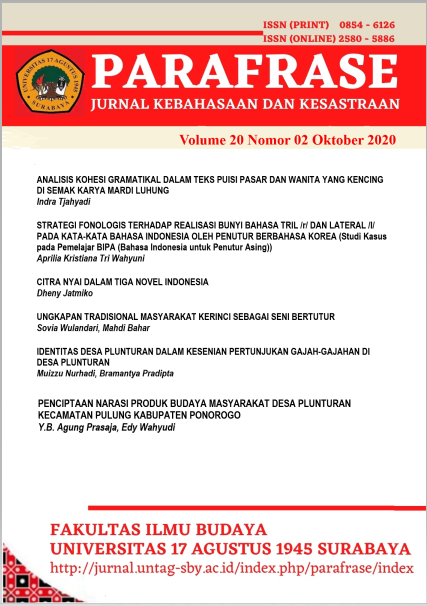PENCIPTAAN NARASI PRODUK BUDAYA MASYARAKAT DESA PLUNTURAN KECAMATAN PULUNG KABUPATEN PONOROGO
DOI:
https://doi.org/10.30996/parafrase.v20i2.4651Abstract
ABSTRACT Narrative can grow and develop regardless of geographical background. Of the various definitions of narrative, most of them relate the two main characteristics of it, namely: 1) events, governed by temporality-chronology of events and their presentation in the text; 2) telling or making a story, as a verbal act of mediation. Narrative is used to accommodate the interests of society such as ideology, nationalism, social relations, cultural order. These aspects include natural aspects, geographical aspects, social aspects, cultural aspects, political aspects, historical aspects, philosophical aspects, anthropological aspects, economic aspects, language aspects, artistic aspects, mythological aspects, technological aspects. Research on the ethnographic aspects of the people of plunturan village seeks to reveal the problems formulated as follows; 1. How is the construction of cultural products built by the villagers of plunturan, pulung district, kab. Ponorogo. 2. How the narrative was created by the villagers of Plunturan Pulung, Ponorogo? The phenomenon of narrative, literary works, art works, and cultural products are entities that are interrelated with one another, this also occurs in the community of plunturan village. Ethnography is defined as a form of investigation that relies heavily on participant observation, at least researchers are in a marginal position, trying to document in detail, patterns of interaction, people's perspectives, and patterns of their daily understanding and manifest the imagination of the people of plunturan kec. Pulung kab ponorogo in narrative form. Keywords: ethnography, narrative, culture, local, interdisciplinaryDownloads
References
https://id.scribd.com/document/350488812/JawApos-20170415
Atkinson, P., Coffey, A., Delamont, S., Lofland, J., & Lofland, L. (2012). Handbook of Ethnography. In Handbook of Ethnography.
Beattie, V., McInnes, B., & Fearnley, S. (2004). A methodology for analysing and evaluating narratives in annual reports: A comprehensive descriptive profile and metrics for disclosure quality attributes. Accounting Forum.
Beicken, P. (2019). Who Is the Narrator? In Dimensions of Storytelling in German Literature and Beyond.
Boellstorff, T., Nardi, B., Pearce, C., & Taylor, T. L. (2012). Ethnography and virtual worlds: A handbook of method. In Ethnography and Virtual Worlds: A Handbook of Method.
Carroll, N. (2015). Narrative. In The Routledge Companion to Philosophy of Literature.
Cronon, W. (1992). A Place for Stories: Nature, History, and Narrative. The Journal of American History.
Gubrium, J. F., & Holstein, J. a. (2008). Narrative Ethnography. Handbook of Emergent Methods.
Hammersley, M., Atkinson, P., Hammersley, M., & Atkinson, P. (2019). What is ethnography? In Ethnography.
Haring, L. (2004). Framing in Oral Narrative. Marvels & Tales.
Hillebrand, J. D., & Berg, B. L. (2000). Qualitative Research Methods for the Social Sciences. Teaching Sociology.
Kelly, M. (2014). Encyclopedia of Aesthetics. In Encyclopedia of Aesthetics.
Mackenzie, C., & Atkins, K. (2008). Practical identity and narrative agency. In Practical Identity and Narrative Agency.
Madison, D. S. (2005). Critical ethnography: Method, ethics, and performance. In Critical Ethnography: Method, Ethics, and Performance. Marsen, S. (2004). To be an actor or to be an observer? A semiotic typology of narrator roles in written discourse. Semiotica.
Mazzoni, G. (2018). ONE: A Theory of Narrative. In Theory of the Novel.
Naidoo, L. (2012). Ethnography: An Introduction to Definition and Method. In An Ethnography of Global Landscapes and Corridors. h
Pillay, V. (2005). Narrative style: the inseparability of self, style and text. Reflective Practice.
Ricoeur, P., Thompson, J. B., Ricoeur, P., & Thompson, J. B. (2016). The narrative function. In Hermeneutics and the Human Sciences.
Segel, E., & Heer, J. (2010). Narrative visualization: Telling stories with data. IEEE Transactions on Visualization and Computer Graphics.
Shklovskii, V. (2019). Art as Technique. In From Symbolism to Socialist Realism.
Smith, C. P. (2000). Content Analysis and Narrative Analysis. Handbook of Research Methods in Social and Personality Psychology.
Spector-Mersel, G. (2010). Narrative research: Time for a paradigm. Narrative Inquiry.
Stapleton, K., & Wilson, J. (2017). Telling the story: Meaning making in a community narrative. Journal of Pragmatics.
Todorov, T. (2014). The Categories of Literary Narrative. Papers on Language and Literature.
Warnecke, E. (2014). The art of communication. Australian Family Physician.
Whitaker, J. A. (2018). Imagination and the Poetics of Being and Becoming an Other in Amazonia. Anthropology of Consciousness.
Downloads
Published
How to Cite
Issue
Section
License
Authors publishing in the Journal will be asked to sign a Copyright Assignment Form. In signing the form, it is assumed that authors have obtained permission to use any copyrighted or previously published material. All authors must read and agree to the conditions outlined in the form, and must sign the form or agree that the corresponding author can sign on their behalf. Articles cannot be published until a signed form has been received.It is a condition of publication that authors assign copyright or license the publication rights in their articles, including abstracts, to email jurnalparafrase@untag-sby.ac.id. . This enables us to ensure full copyright protection and to disseminate the article, and of course the Journal to the widest possible readership in print and electronic formats as appropriate.



















